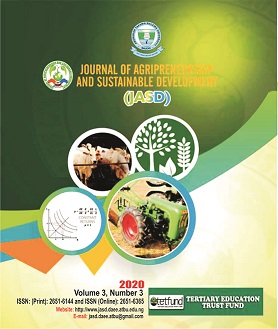TECHNICAL EFFICIENCY OF RICE PRODUCTION IN SOUTHERN TARABA STATE, NIGERIA
DOI:
https://doi.org/10.59331/jasd.v3i3.145Keywords:
Likelyhood estimate, production function, rice production, stochastic frontier, Technical efficiencyAbstract
The study evaluated technical efficiency of rice production in Southern Taraba State, Nigeria. Multi stage sampling procedure was employed in selecting 133 respondents for the study. Primary data used in the study were collected using structured questionnaire administered to respondents. Data collected were analyzed using descriptive statistics and stochastic frontier production function. Result of the study indicated that majority (80.45%) of the respondents was male; the average age of the farmers was 39 years, majority (67%) of the respondents was married. The average household size was five (5) people per household. The average farming experience of the farmers was 15 years; majority (76%) of the respondents had formal education. The average farm size of the farmers was 2 hectare, 69.17% of the rice farmers do not have access to credit, and most (75.94%) of the respondents did participate in any cooperative association. Majority (95.49%) of the respondents did not have access to extension contacts. The maximum likelihood estimate of stochastic frontier production function for rice farmers were all positive, that is, farm size, seed used, fertilizer and labor except for herbicide and cost of ploughing which were negative. It was concluded that rice farmers were efficient in their production with mean efficiency index of 87%. It was recommended that, farmers should use the available resources efficiently to attain maximum output.
Downloads

Downloads
Published
How to Cite
Issue
Section
License
Copyright (c) 2022 Journal of Agripreneurship and Sustainable Development

This work is licensed under a Creative Commons Attribution 4.0 International License.






